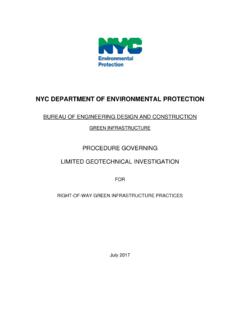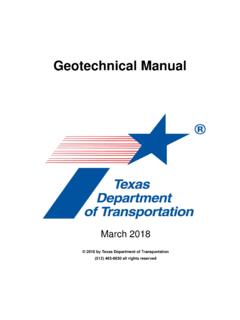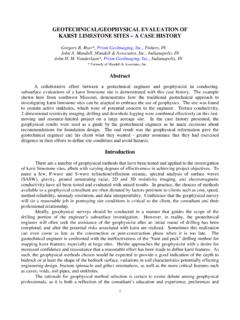Transcription of Failing Culverts – The Geotechnical Perspective
1 Tenbusch, Inc. 972-221-2304 Brierley Assoc. 603-206-5775 1 Failing Culverts The Geotechnical Perspective Al Tenbusch, President, Tenbusch, Inc. Brian Dorwart, Senior Associate, Brierley Associates Al F. Tenbusch, Engineer, Tenbusch, Inc. August 2009 Tenbusch, Inc. 972-221-2304 Brierley Assoc. 603-206-5775 2 Introduction The economic stimulus program has brought significant attention to the need to maintain and improve our nation s infrastructure. Noteworthy is the high failure rate of flexible pipe Culverts , most of which are corrugated metal, under our federal, state, and local highways.
2 Some recent failures have been catastrophic as highways collapse without warning, and most occur in high traffic volume areas. With today s economic realities, it is more important than ever to closely scrutinize these failures and develop long term, cost effective, site appropriate, solutions. To do this it is necessary to consider the fundamental modes of culvert failure and possible solution options from a Geotechnical Perspective . Three important events that shaped the use of flexible corrugated metal pipes since the beginning when James Watson and Stanley Simpson were granted a Patent for corrugated metal pipe (CMP) around the turn of the century (late 1890s): 1.
3 Starting in the 1930s, Merlin Spangler, the father of buried flexible pipe design provided a standardized method for installing buried pipe and showed that structural pipe bedding could provide structural support for flexible pipes such as CMP and the overlying pavement. 2. June 29, 1956, America began in earnest to build highways (and Culverts ) when President Eisenhower signed the Federal-Aid Highway Act of 1956. Corrugated pipe, and in particular, CMP, was generally the material of choice on these low bid projects because of relative low cost for a given strength of the pipe.
4 The corrugation added strength while permitting a reduction in wall metal thickness resulting in lower pipe material cost per foot of pipe. 3. In 1976 the introduction of the Federal High-Way Administration (FHWA) sponsored CANDE ( culvert ANalysis and DEsign) program provided a rational design method for Culverts that acknowledged the significant effects of soil to structure interaction in the stability of buried Culverts and the overlying pavement. Results showed that for CMP applications, the structural soil fill surrounding the pipe and the pipe form a co-dependent composite structure.
5 Unfortunately, elevated failure rates should be expected as many of the 50s vintage Culverts age and highway maintenance funds have been redirected to tasks other than maintenance of Culverts . Like other highway structures, flexible Culverts have a given lifespan starting at their time of installation depending on design and installed conditions. Initially, the life cycle can be economically extended by relatively low cost routine maintenance such as headwall and pavement maintenance and by cleaning. As the culvert ages, the components start corroding or deteriorate by abrasion and structural fill properties can deteriorate.
6 Pipe damage that has not compromised the soil support system can still be cost effectively maintained and rehabilitated. Rehabilitation options include invert paving and slip lining with an array of different pipe products along with grouting the annular space. In areas where fire is not a possibility, these liners can include different plastic products such as cured in place epoxy composites or a fold and form liner. However, once the culvert and soil structure have both been compromised or a failure has occurred, the structure has reached the end of its service life and must be replaced.
7 Tenbusch, Inc. 972-221-2304 Brierley Assoc. 603-206-5775 3 What many see as simply a flexible pipe failure is much more it is the failure of the soil/pipe structure. This paper will examine fundamental elements associated with failure of flexible buried Culverts . It is expected that those who are facing the challenges of replacing or repairing the Failing Culverts will readily recognize the realities of the failure mode explanations laid out here and the need for addressing both the pipe and the supporting soil to both restore the failed culvert and maintain the integrity of the overlying pavement.
8 Let us start by examining the work of those who went before us in the construction of the culvert system. Installation specifications called for over excavation under the pipe and placement of a sound layer of bedding material that would serve to support the pipe and provide drainage for the surrounding soil to reduce the potential corrosion from groundwater. The pipe was then laid on the sound bedding. Free draining structural fill was then installed along the haunches and compacted in a manner so as to not heave the pipe by forcing material under the haunches.
9 When the well drained structural fill was installed and compacted in lifts to a level near the top of the pipe, the final backfill lift over the crown was placed, and the final compaction effort finished the job. The remaining trench was then backfilled to final grade and in some areas where there was to be an embankment work began to build the embankment to the final grade. These are the conditions under which most Culverts start their life and where aging begins. culvert aging is a function of the impact of environmental factors on the culvert and soil composite system.
10 These impact factors change the structural properties of the pipe and/or the surrounding supporting soil that make the composite system stable. Deterioration of the properties of these structural elements leads to mechanical failure such as seam separation, buckling failure of the invert or crown as pipe material or supporting soil structure weakens, or catastrophic removal of structure components by erosion or physical damage such as by fire. Buckling is probably the most common of the failure modes and bares additional explanation regarding the soil and pipe system interaction to understand the meaning of why the flexible pipe and soil are considered to be a composite structure.







